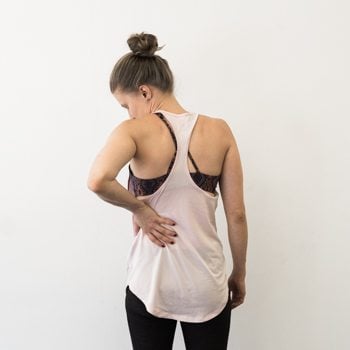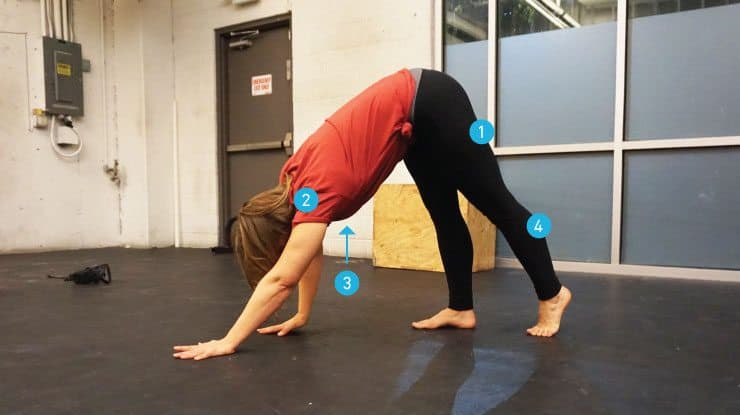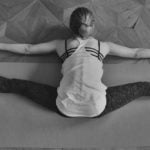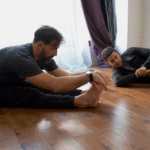You’ve got some tight areas in your body that are holding you back from doing the things you want to do. So, you pull up ye ‘olde Google, search for “how to improve flexibility,” and what do you find?
- Hundreds of pictures of half-naked contortionists.
- Tons of misinformation about how stretching will hurt you.
- Complicated and unhelpful routines that espouse “just stretching more” to reach your goals.
…in other words, very little that will help you actually improve your flexibility.
Don’t worry, that’s all about to change 🙂

We’ve helped tens of thousands of clients get more flexible, without the headaches and frustrations that usually go along with typical stretching regimens. And in this article, we’ll show you a better way to improve your flexibility than you’ve probably tried before.
Here’s what you’ll find in this article:
- Quick example of dynamic stretching
- Why should you even care about getting more flexible?
- The way most people try (and fail) to get more flexible
- Busting 3 big myths about stretching
- 3 dynamic stretching movements to get more flexible
Sound good? Let’s do this.
Dynamic Stretching Movement Combo
Probably the easiest way to understand what “dynamic flexibility” really means is just to see an example, so here’s a movement combo Ryan made for hamstring and lower-body stretching:
You could just stop here, practice those moves, and be on your way to getting more flexible.
But we’re gonna go a few steps further and teach you how to pick the right dynamic stretching movements for your own needs. This involves getting a clear picture of what those needs are as well as letting go of some antiquated ideas about how to get flexible.
We’ll also show you our top three go-to movements for building mobility and dynamic flexibility.
Why Do You Want to Be More Flexible?
 Many people think flexibility is about being able to do the splits or crazy contortionist backward bending. But unless you’re planning to quit your job to become a circus performer, that level of flexibility will never be necessary for your daily life.
Many people think flexibility is about being able to do the splits or crazy contortionist backward bending. But unless you’re planning to quit your job to become a circus performer, that level of flexibility will never be necessary for your daily life.
What is necessary, though, is having enough flexibility to do the things you want and need to do, without mobility restrictions getting in your way.
Of course, your particular needs will depend on what your life looks like.
Some people have more day-to-day needs, like reaching overhead to change a lightbulb, or squatting down to pick up a toddler, that are currently restricted.
You may have more specific needs related to a sport or favorite activity (like running or Muay Thai).
Whatever your life looks like, you need access to enough mobility to be able to do the things you want to do with ease. This will not only make your life a lot more pleasant, but it’ll also protect you from injuries that may result from trying to force things.
If flexibility restrictions are getting in your way, it’s time to address those.
How People Typically Try to Get More Flexible (and why it usually doesn’t work)
 One of our favorite jokes around GMB HQ, whenever we see someone who’s made amazing progress with their flexibility, is “Stretching doesn’t work.”
One of our favorite jokes around GMB HQ, whenever we see someone who’s made amazing progress with their flexibility, is “Stretching doesn’t work.”
Of course stretching works!
People have been stretching in countless ways for thousands of years. If it didn’t work, we probably would have figured that out by now, right?
There are two main problems with the way most people stretch, though:
- They use random stretches that don’t necessarily target their particular needs.
- They follow painful, boring stretching protocols that they’ll never be able to stay consistent with.
Stretching works when done right, but if your efforts don’t match your needs, or you can’t actually stick to the program you’re working on, you’ll never make the progress you want. And that’s when people say things like, “stretching doesn’t work.”
Our free Strength and Mobility Kickstart will help you incorporate these locomotive exercises (and more) to not only improve your flexibility, but also your strength and overall movement abilities.
Common Myths About Stretching
There are many misconceptions about stretching and getting more flexible, but we’ll just look at a few here. When you read an article or hear someone talking about why you shouldn’t stretch, they’re usually going to be coming from one of three main arguments:
- Stretching is dangerous
- Stretching is unrealistic
- Stretching isn’t real
Let’s break these down.
Myth #1–“Stretching is Dangerous”
 This is absolutely true. Other things that are dangerous: eating (poison), breathing (car exhaust), and sleeping (in the bath tub).
This is absolutely true. Other things that are dangerous: eating (poison), breathing (car exhaust), and sleeping (in the bath tub).
Yes, that’s right. Anything can be dangerous if you do it wrong, and stretching is certainly no exception. Sure, I’m guilty of cherry picking extreme examples above to make my point (logical fallacies can be fun sometimes), but anyone who claims outright that all stretching is dangerous is at least as guilty.
Like anything else, stretching can be dangerous if you do it wrong.
But proper stretching, and other methods of improving flexibility, are good for you, and important for gaining the ranges of motion you need for your life.
Myth #2–“Stretching Is Unrealistic”
 Pop Quiz: A mugger jumps out of a dark alley and demands you hand over your wallet and your keys. Do you:
Pop Quiz: A mugger jumps out of a dark alley and demands you hand over your wallet and your keys. Do you:
- A) Run like hell,
- B) Comply with his demands, or
- C) Ask him to wait five minutes while you stretch and warm up so you can adequately defend yourself?
Okay, in all honesty, you may not be too enamored of any of the choices above, but you have to admit that, of the three, choice C sounds pretty ridiculous.
This is the logic of certain “tactical” schools of thought on the subject of warming up–that if train your body to rely on warm-up stretches before it goes into “action,” you won’t be able to do the things you need to do when push comes to shove.
And maybe that’s true for first responders (though I’d argue they could still benefit from better ranges of motion).
For most of us, though, we can afford to slow down, warm up, and give our bodies the optimal environment for improving at the things that matter.
Myth #3–“Stretching Doesn’t Exist”
 This myth is the “I think my clever semantic observations about the word ‘stretch’ nullify the experience of millions of people who have successfully stretched and gotten more flexible” argument.
This myth is the “I think my clever semantic observations about the word ‘stretch’ nullify the experience of millions of people who have successfully stretched and gotten more flexible” argument.
In a sort of weird, hair-splitting way, I guess this is true.
As the argument goes, muscles don’t actually stretch; a fully relaxed muscle is up to 50% longer than a muscle in its typical semi-contracted state. Therefore, “stretching” a muscle doesn’t so much elongate its fibers as it simply trains them to hold less unnecessary tonus.
People who make this argument will also tend to plead a case for prioritizing the development of “mobility” instead of “flexibility.” And again, we think this is just a semantic issue.
The fact is, you can call it what you like.
We “stretch” in order to increase our functional range of motion of various joints in various positions. Yes, we could probably come up with much more accurate and technical-sounding ways to describe that, but we’d much rather spend our time designing super-effective programs, testing them with real people, and teaching them to our clients.
Stretching may not be the best possible word to describe our method for increasing flexibility/mobility, but it’s something that people understand, and it works.
Dynamic Stretching: A Movement-Based Approach to Flexibility
 I’m a big fan of stretching. That’s why I made our Mobility program, and in my 20 years as a physical therapist, I’ve found it to be an important part of injury prevention and recovery.
I’m a big fan of stretching. That’s why I made our Mobility program, and in my 20 years as a physical therapist, I’ve found it to be an important part of injury prevention and recovery.
But for many people, especially for those who’ve tried a lot of standard stretching protocols without good results, a movement-based, dynamic stretching approach can do wonders for improving flexibility.
There are many movements you could use, but the following three are great for targeting some of the most common flexibility concerns for many people. Working on your flexibility in this way is a lot more fun (so you’re more likely to stay consistent with your practice), and adjustable to your particular needs (so you’re more likely to get what you need out of your practice).
Bear
In the Bear, you’ll start in an A-Frame (or downward dog) position, then move your right hand and left foot simultaneously, then vice versa.
Depending on where you place the emphasis on the movement, or depending on your particular limitations, the Bear can be used to help you stretch your:

- hamstrings
- shoulders
- thorax
- calves
If you have limitations in your calves, for instance, you can focus on locking out the knee and driving the heel to the floor.
Monkey
With the Monkey, you’ll start in a bodyweight squat (go as deep as you can), then place your hands on the ground in front of you and to the side. If you are moving to the right, you’ll place your left hand in front of your right foot, then hop your feet to the right, landing with your left foot behind your right hand.
If you have trouble getting into a deep squat, the Monkey can help by stretching your:

- hips
- calves
- adductors
- upper back
- lats
If you have tight lats, for instance, a variation of the monkey that would be great to work on is the monkey cartwheel, where you reach your arm overhead to create the momentum for the cartwheel. This creates a nice stretch in the lats.
Frogger
The frogger is similar to the monkey, in that it starts in a deep squat, but instead of moving side to side, you’ll place your hands in front of you, then hop your feet forward to meet your hands, moving forward in succession.
Much like the Monkey, the Frogger will help you out tremendously with your squat flexibility, but with a slightly different angle. Putting the Frogger in motion will stretch your:

- hips
- calves
- adductors
- upper back
If your squat is limited by calf tightness, reaching further forward in the Frogger will help stretch your calves a bit more.
Working on these locomotive movements will help you improve your overall flexibility (along with strength, motor control, and general movement quality). As you practice these movements, you’ll likely discover specific areas that are particularly tight.
That’s where GMB Mobility will come in handy, to help you target specific needs alongside improving general movement and mobility.
Make the Progress You Want, Without the Frustration
If stretching for hours on end just hasn’t worked for you in the past, locomotive movements like we just saw are a great way to “trick” your body into improving flexibility without all the frustration that can often accompany a standard approach to stretching.
Build Flexibility That Actually Helps You Move
GMB Mobility is a guided program that improves your total body mobility. You’ll resolve restrictions so you can finally move and perform your best.






